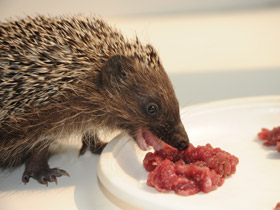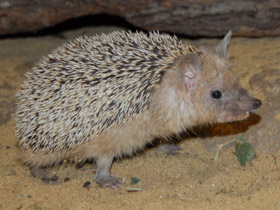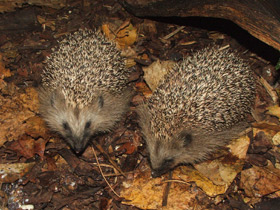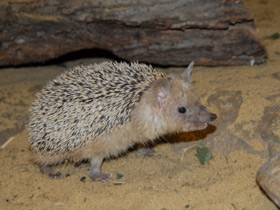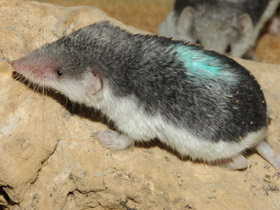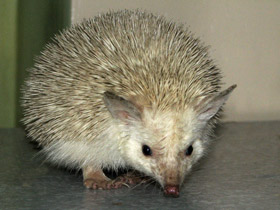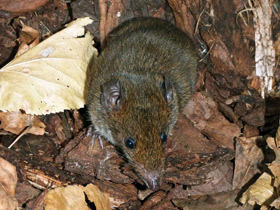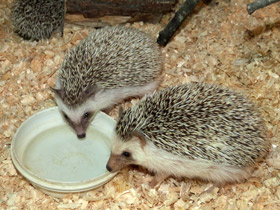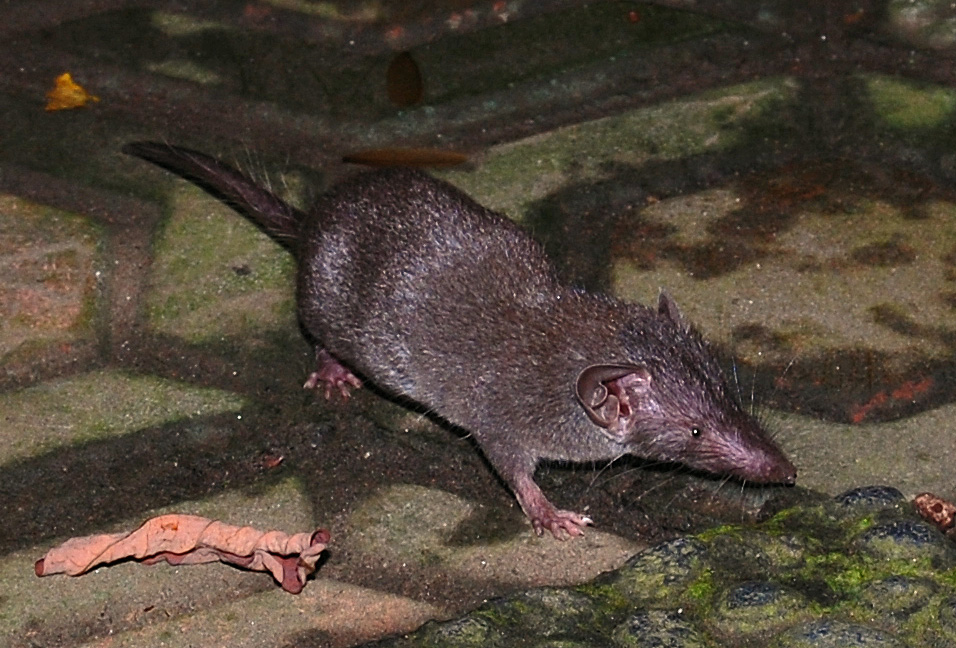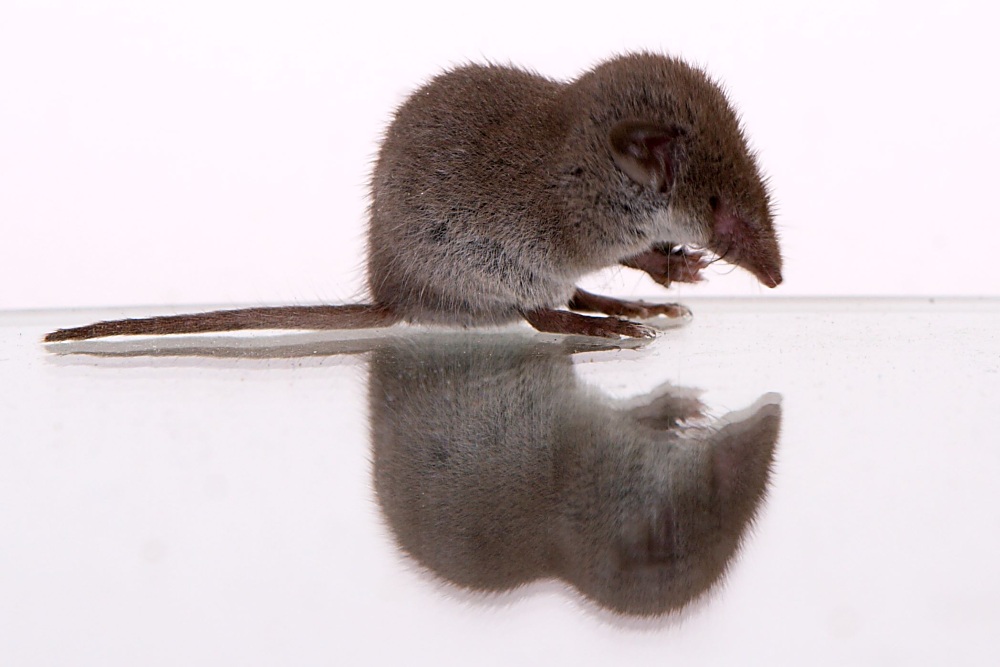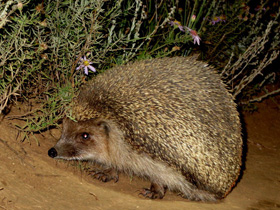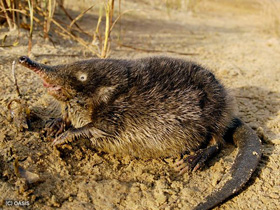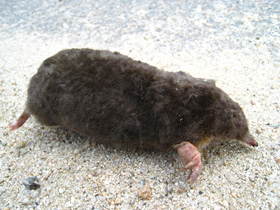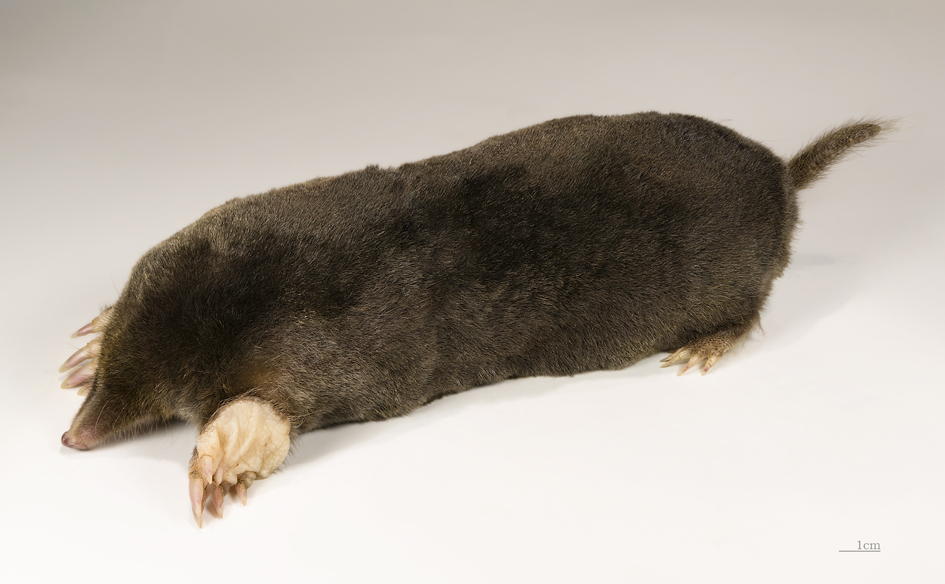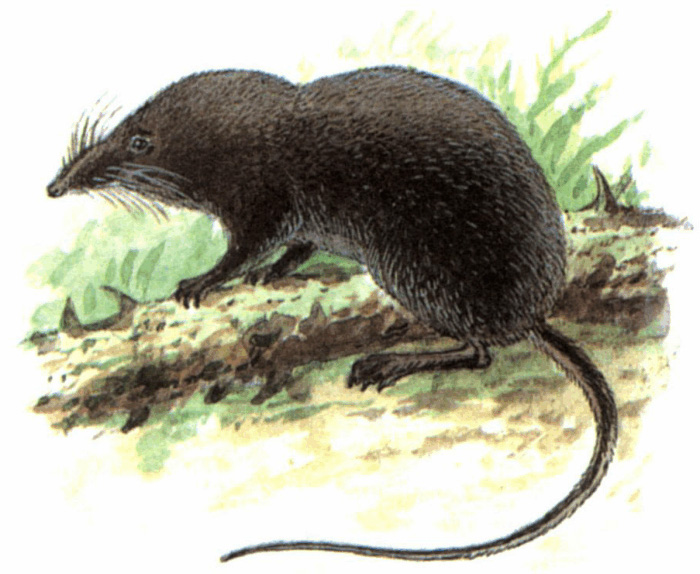The order Insectivora
The order Insectivora (from Latin insectum "insect" and vorare "to eat") is a now-abandoned biological grouping within the class of mammals. Some species have now been moved out, leaving the remaining ones in the order Eulipotyphla within the larger clade Laurasiatheria, which makes up one of the basal clades of placental mammals.
Distinguishing features of Insectivores (Eulipotyphla or Lipotyphla; formerly Insectivora)
This group includes animals that are completely different in appearance and lifestyle, living on every continent except Australia. Usually they do not cause people any sympathy. And, by the way, for nothing! Almost all of them are useful, destroying a huge number of harmful insects. Insectivora - animals are very ancient, their ancestors lived on our planet already 135 million years ago, when the earth still roamed the dinosaurs. According to modern data, there are about 400 species in the group, and it is the third largest (after rodents and rats) of mammals. Some features allow to consider insectivores and the most primitive of placental mammals - it is primarily their small size, simply arranged limbs and teeth. They do not chew and grind food, but only bite and crush it, so they are quite "satisfied" with small, almost identical and very sharp teeth. The muzzle of Insectivora is elongated and usually ends in a small trunk, eyes and external ear flaps are small, some are strongly reduced. Their fur is short and soft, the body of some of them is covered with spines, the brain is very small and practically has no furrows and crinkles. Insectivora lead terrestrial, subterranean, semi-aquatic or even arboreal lives. They are not easy to see because most are active at night. As the name suggests, these animals feed mainly on insects, but some are true predators. Insectivores are characterised by an extremely high metabolism and the associated extraordinary voracity: small shrews eat twice as much as they weigh in a day and can live without food for only a few hours. Another distinctive feature of the animals of this group is their amazing fecundity: females can give birth to up to 15 cubs.
Classification
ORDER EULIPOTYPHLA (remnant of 'Insectivora'):
- Family Erinaceidae:
- Subfamily Erinaceinae: hedgehogs;
- Subfamily Hylomyinae: moonrats and gymnures;
- Family Soricidae:
- Subfamily Crocidurinae: white-toothed shrews;
- Subfamily Soricinae: red-toothed shrews;
- Subfamily Myosoricinae: African white-toothed shrews;
- Family Talpidae:
- Subfamily Desmaninae: desmans;
- Subfamily Talpinae: moles;
- Subfamily Uropsilinae: shrew moles;
- Family Solenodontidae: solenodons;
- Family Nesophontidae: extinct West Indian shrews.
These families have been placed within Insectivora in the past:
- Family Chrysochloridae (golden moles);
- Family Tenrecidae (tenrecs);
- Family Potamogalidae (otter shrews);
- Family Macroscelididae (elephant shrews);
- Family Tupaiidae (true treeshrews);
- Family Ptilocercidae (pen-tailed treeshrew);
- Family Cynocephalidae (colugos).
Not to be confused with insectivores (the eaters of insects considered as a feeding behavior), many of which do not belong to Eulipotyphla or the other taxa formerly included within Insectivora.
The family Erinaceidae
Erinaceidae /ˌɛrɪnəˈsiːɪdiː/ is a family in the order Eulipotyphla, consisting of the hedgehogs and moonrats. Until recently, it was assigned to the order Erinaceomorpha, which has been subsumed with the paraphyletic Soricomorpha into Eulipotyphla. Eulipotyphla has been shown to be monophyletic; Soricomorpha is paraphyletic because Soricidae shared a more recent common ancestor with Erinaceidae than with other soricomorphs.
Erinaceidae contains the well-known hedgehogs (subfamily Erinaceinae) of Eurasia and Africa and the gymnures or moonrats (subfamily Galericinae) of South-east Asia. This family was once considered part of the order Insectivora, but that polyphyletic order is now considered defunct.
Erinaceidae is the most ancient and primitive family of the order. People have known them for a very long time; in ancient times, hedgehog skins dried and stretched on planks were used to make combs for sheep's wool. As a result, hedgehogs became so scarce that the Senate of ancient Rome even issued a decree to protect them. Science knows no less than 30 species of hedgehogs, and, it turns out, not all of them are similar to our familiar prickly inhabitant of forests and parks. There are in nature and quite different, primitive hedgehogs, covered with hair, not needles, and resembling the appearance of rodents. Still, the most famous feature of hedgehogs is their ability to curl up in a ball in case of danger, giving a likely enemy a prickly back and hiding unprotected face and abdomen. (And the hedgehog has a lot of needles - 6-7 thousand!) Interestingly, some hedgehogs strengthen the effect of their prickles, lubricating them with poisonous liquid. To do this, they catch toads, bite their parotid glands and lubricate them with needle secretions. When pricked with such "poisoned arrows" there is a strong burning sensation that does not go away for several hours.
Erinaceidae have very fine hearing and excellent sense of smell, allowing them to sense prey at a depth of several metres underground. But their eyesight is weak, but it is not so important for a nocturnal animal. In winter, hedgehogs sleep in a den of grass, leaves and moss. During this period, their body temperature drops to 2-3 degrees, and the frequency of breathing up to 6-8 times per minute. All winter they eat nothing and live off the fat reserves accumulated since autumn: before hibernation, hedgehogs weigh 700-950 g, but in spring they weigh no more than 350 g. The hedgehog also builds a special den for her offspring, where she gives birth to 5-6 (sometimes 3 to 10) hedgehogs. The newborns are blind, deaf and naked, but after a few hours they develop soft white needles. They grow very quickly, become darker and in a week or two become the same as adults. Hedgehogs feed mainly on various invertebrates (spiders, slugs, worms, insects), but they do not refuse mice, frogs and chicks. They also eat berries, fruits and seeds of plants. The hedgehog eats a lot and overnight eats as much as it weighs itself.
For some reason, there are many legends about hedgehogs - for example, that they are excellent (not worse than mongoose) snake-eaters or that they carry apples on their needles. In fact, hedgehogs do not specifically track snakes, although they can really in case they can deal with a large viper. But their resistance to various poisons is really amazing. Thus, compared to a guinea pig of the same size, hedgehogs tolerate 35-40 times higher doses of snake or wasp venom. As for apples on needles, perhaps this legend is not groundless. The fact is that hedgehogs suffer from numerous parasites that settle between their needles (lice, fleas, ticks, etc.) To get rid of them, they use strongly smelling substances, ride on carrion, "bathe" in anthills and even string cigarette butts on their needles. The sour juice of apples threaded on needles may also be suitable for the same purpose.
Classification
Order Eulipotyphla:
- †Family Amphilemuridae:
- †Genus Alsaticopithecus;
- †Genus Amphilemur;
- †Genus Gesneropithex;
- †Genus Macrocranion:
- †Macrocranion germonpreae;
- †Macrocranion junnei;
- †Macrocranion nitens;
- †Macrocranion robinsoni;
- †Macrocranion tenerum;
- †Macrocranion vandebroeki;
- †Genus Pholidocercus;
- †Pholidocercus hassiacus;
- Family Erinaceidae:
- †Genus Silvacola:
- †Silvacola acares;
- †Genus Oligoechinus;
- Subfamily Erinaceinae:
- †Genus Amphechinus;
- †Amphechinus akespensis;
- †Amphechinus arverniensis;
- †Amphechinus baudelotae;
- †Amphechinus edwardsi;
- †Amphechinus ginsburgi;
- †Amphechinus golpeae;
- †Amphechinus horncloudi;
- †Amphechinus intermedius;
- †Amphechinus kreuzae;
- †Amphechinus major;
- †Amphechinus microdus;
- †Amphechinus minutissimus;
- †Amphechinus robinsoni;
- †Amphechinus taatsiingolensis;
- Genus †Ladakhechinus:
- †Ladakhechinus iugummontis;
- Genus Atelerix:
- Four-toed hedgehog, Atelerix albiventris;
- North African hedgehog, Atelerix algirus;
- Southern African hedgehog, Atelerix frontalis;
- Somali hedgehog, Atelerix sclateri;
- Genus Erinaceus:
- Amur hedgehog, Erinaceus amurensis;
- Southern white-breasted hedgehog, Erinaceus concolor;
- European hedgehog, Erinaceus europaeus;
- Northern white-breasted hedgehog, Erinaceus roumanicus;
- Genus Hemiechinus:
- Long-eared hedgehog, Hemiechinus auritus;
- Indian long-eared hedgehog, Hemiechinus collaris;
- Genus Mesechinus:
- Daurian hedgehog, Mesechinus dauuricus;
- Hugh's hedgehog, Mesechinus hughi;
- Gaoligong forest hedgehog, Mesechinus wangi;
- Small-toothed forest hedgehog, Mesechinus miodon;
- Genus Paraechinus:
- Desert hedgehog, Paraechinus aethiopicus;
- Brandt's hedgehog, Paraechinus hypomelas;
- Indian hedgehog, Paraechinus micropus;
- Bare-bellied hedgehog, Paraechinus nudiventris;
- Subfamily Galericinae:
- †Genus Deinogalerix:
- †Deinogalerix brevirostris;
- †Deinogalerix freudenthali;
- †Deinogalerix intermedius;
- †Deinogalerix koenigswaldi;
- †Deinogalerix minor;
- Genus Echinosorex:
- Moonrat, Echinosorex gymnura;
- †Genus Galerix:
- †Galerix aurelianensis;
- †Galerix exilis;
- †Galerix kostakii;
- †Galerix remmerti;
- †Galerix rutlandae;
- †Galerix saratji;
- †Galerix stehlini;
- †Galerix symeonidisi;
- †Galerix uenayae;
- Genus Hylomys:
- Long-eared gymnure, Hylomys megalotis;
- Dwarf gymnure, Hylomys parvus;
- Short-tailed gymnure or Lesser Moonrat, Hylomys suillus;
- Genus Neohylomys:
- Hainan gymnure, Neonylomys hainanensis;
- Genus Neotetracus:
- Shrew gymnure, Neotetracus sinensis;
- Genus Podogymnura:
- Dinagat gymnure, Podogymnura aureospinula;
- Eastern Mindanao gymnure, Podogymnura intermedia;
- Podogymnura minima;
- Mindanao gymnure, Podogymnura truei.
Shrews (family Soricidae)
Shrews (family Soricidae) are small mole-like mammals classified in the order Eulipotyphla. True shrews are not to be confused with treeshrews, otter shrews, elephant shrews, West Indies shrews, or marsupial shrews, which belong to different families or orders.
The most extensive family of the order is Soricidae. (Some modern systematists distinguish this family from the Insectivores and assign it the status of a separate order of shrews Soricomorpha). It has more than 300 species (only in Russia there are 25), and scientists still continue to describe more and more new ones. Because of the strong odour Soricidae are not eaten by many predators, and perhaps that is why people have long attributed to them many magical and medicinal properties, and at the same time panic-stricken afraid of them.
Soricidae are the smallest among insectivores, and dwarf white-toothed - in general among all mammals (its weight is 1.5 g and body length is 3.5 cm). Soricidae are similar to mice in appearance, but are distinguished by their large head, the facial part of which is elongated into a proboscis. They inhabit a wide variety of landscapes - from tundra to tropical forests and deserts, climbing up to 4,500 metres in the mountains. Their movements are agile and light, they can quickly run on the ground, make tracks in the forest floor, jump quite high, and if necessary, and swim. Soricidae feed on various invertebrates, but also attack small vertebrates: frogs, lizards, baby rodents, "showing bravery, bloodthirstiness and ferocity, not corresponding to their small size" (as A. Brehm writes). Every day Soricidae eat an amount of food twice their weight. High level of metabolism forces them to round-the-clock activity and does not allow them to hibernate. Soricidae are short lived, not more than 2 years, but they are very prolific, having 2-3 litters of 4-14 cubs per year.
Classification
The 385 shrew species are placed in 26 genera, which are grouped into three living subfamilies: Crocidurinae (white-toothed shrews), Myosoricinae (African shrews), and Soricinae (red-toothed shrews). In addition, the family contains the extinct subfamilies Limnoecinae, Crocidosoricinae, Allosoricinae, and Heterosoricinae (although Heterosoricinae is also commonly considered a separate family).
Family Soricidae:
- Subfamily Crocidurinae:
- Crocidura;
- Diplomesodon;
- Feroculus;
- Palawanosorex;
- Paracrocidura;
- Ruwenzorisorex;
- Scutisorex;
- Solisorex;
- Suncus;
- Sylvisorex;
- Subfamily Myosoricinae:
- Congosorex;
- Myosorex;
- Surdisorex;
- Subfamily Soricinae:
- Tribe Anourosoricini;
- Anourosorex;
- Tribe Blarinellini;
- Blarinella;
- Tribe Blarinini;
- Blarina;
- Cryptotis;
- Tribe Nectogalini;
- Chimarrogale;
- Chodsigoa;
- Episoriculus;
- Nectogale;
- Neomys;
- †Asoriculus;
- †Nesiotites;
- Soriculus;
- Tribe Notiosoricini;
- Megasorex;
- Notiosorex;
- Tribe Soricini;
- Sorex.
The family Talpidae
The family Talpidae (/ˈtælpɪdiː/) includes the moles (some of whom are called shrew moles and desmans) who are small insectivorous mammals of the order Eulipotyphla. Talpids are all digging animals to various degrees: moles are completely subterranean animals; shrew moles and shrew-like moles somewhat less so; and desmans, while basically aquatic, excavate dry sleeping chambers; whilst the quite unique star-nosed mole is equally adept in the water and underground. Talpids are found across the Northern Hemisphere of Eurasia and North America (although none are found in Ireland nor in the Americas south of northern Mexico), and range as far south as the montane regions of tropical Southeast Asia.
The first talpids evolved from shrew-like animals which adapted to digging late in the Eocene in Europe. Eotalpa anglica is the oldest known mole, it was discovered in the Late Eocene deposits of Hampshire Basin, UK. The most primitive living talpids are believed to be the shrew-like moles, with other species having adapted further into the subterranean, and, in some cases, aquatic lifestyles.
In the Talpidae family, which includes about 20 species, in addition to the familiar subterranean inhabitants, there are also terrestrial primitive forms, similar in appearance to shrews, and semi-aquatic ones. The common mole is widespread in Europe and Asia. It is not easy to see it, but to recognise its presence is simple - by small piles of earth (moleholes). Everything about this small animal is adapted for living in the ground: its body is streamlined and covered with dense short velvety fur, consisting of almost one undercoat. This fur allows the mole to move with equal ease in narrow passages both head and tail forward. However, due to the constant friction with the ground, the fur quickly wears out, so unlike other animals, the mole moults moult 3-4 times a year. The mole's ears and eyes are quite small and covered by folds of skin. But the most amazing of all, of course, its forelimbs: powerful, short, shovel-like, with strong claws and turned palms, they are excellent digging tools. The mole finds its food (earthworms, insects and their larvae, molluscs and other invertebrates) with the help of a well-developed sense of smell and hearing. In a day he breaks through about 20 metres of new underground passages, and their total length - dozens of kilometres. Dachnikov, of course, the activity of moles is not very happy, but scientists believe that these animals bring a lot of benefit, and not only that they destroy harmful insects. The fact is that the land that moles take out of the depths is very fertile, because it is much richer in minerals than the surface layers of soil.
Widespread use of beautiful and durable fur Talpidae began relatively recently, in the late XIX century. Up to now in the fur trade of our country the extraction of mole skins is in the sixth place (and in the European part and in the Urals even in the first place!). Around the world, up to 20 million mole skins are harvested per year.
In North America there is a mole with a completely unusual appearance. It is The star-nosed mole (Condylura cristata), a rather large animal up to 20 cm long. At the end of its muzzle there is an oval disc, from which 22 fleshy, thin outgrowths depart in rays - with them the star-nosed mole feels and captures the prey. These moles not only dig holes in the ground, but also swim and dive very well.
Classification
The family is divided into three subfamilies, 19 genera and 59 species.
Family Talpidae:
- Subfamily Uropsilinae - Asian shrew-like moles (Chinese shrew moles):
- Genus Uropsilus - eight species in China, Bhutan, and Myanmar:
- Equivalent-teeth shrew mole, Uropsilus aequodonenia;
- Anderson's shrew mole, Uropsilus andersoni;
- Black-backed shrew mole, Uropsilus atronates;
- Dabie Mountains shrew mole, Uropsilus dabieshanensis;
- Gracile shrew mole, Uropsilus gracilis;
- Inquisitive shrew mole, Uropsilus investigator;
- Snow Mountain shrew mole, Uropsilus nivatus;
- Chinese shrew mole, Uropsilus soricipes;
- Subfamily Scalopinae - New World moles:
- Tribe Condylurini - condylurine moles;
- Genus Condylura - one species in eastern North America:
- Star-nosed mole, Condylurini cristata;
- Tribe Scalopini - scalopine moles;
- Genus Alpiscaptulus - one species in China:
- Medog mole, Alpiscaptulus medogensis;
- Genus Parascalops - one species in northeastern North America:
- Hairy-tailed mole, Parascalops breweri;
- Genus Scalopus - one species in eastern North America:
- Eastern mole, Scalopus aquaticus;
- Genus Scapanulus - one species in China;
- Gansu mole, Scapanulus oweni;
- Genus Scapanus - five species in western North America:
- Mexican mole, Scapanus anthonyi;
- Northern broad-footed mole, Scapanus latimanus;
- Southern broad-footed mole, Scapanus occultus;
- Coast mole, Scapanus orarius;
- Townsend's mole, Scapanus townsendii;
- Subfamily Talpinae - Old World moles, desmans, and shrew moles:
- Tribe Talpini - talpine moles;
- Genus Euroscaptor - ten species in East, South, and Southeast Asia:
- Greater Chinese mole, Euroscaptor grandis;
- Kloss's mole, Euroscaptor klossi;
- Kuznetsov's mole, E. Kuznetsovi;
- Long-nosed mole, E. Longirostris;
- Malaysian mole, E. malayanus;
- Himalayan mole, E. Micrurus;
- Ngoc Linh mole, E. Ngoclinhensis;
- Orlov's mole, E. Orlovi;
- Small-toothed mole, E. Parvidens;
- Vietnamese mole, E. Subanura;
- Genus Mogera - nine species from East Asia:
- Echigo mole, M. Etigo;
- Small Japanese mole, M. Imaizumii;
- Insular mole, M. Insularis;
- Kano's mole, M. Kanoana;
- La Touche's mole, M. Latouchei;
- Ussuri mole, M. Robusta;
- Sado mole, M. Tokudae;
- Senkaku mole, M. Uchidai;
- Japanese mole, M. Wogura;
- Genus Oreoscaptor - one species in Japan:
- Japanese mountain mole, O. Mizura;
- Genus Parascaptor - one species in southern Asia:
- White-tailed mole, P. Leucura;
- Genus Scaptochirus – China:
- Short-faced mole, S. Moschatus;
- Genus Talpa - thirteen species, Europe and western Asia:
- Altai mole, T. Altaica;
- Aquitanian mole, T. Aquitania;
- Blind mole, T. Caeca;
- Caucasian mole, T. Caucasica;
- Père David's mole, T. Davidiana;
- European mole, T. Europaea;
- Levant mole, T. Levantis;
- Martino's mole, T. Martinorum;
- Spanish mole, T. Occidentalis;
- Ognev's mole, T. Ognevi;
- Roman mole, T. Romana;
- Balkan mole, T. Stankovici;
- Talysch mole, T. Talyschensis;
- Tribe Scaptonychini;
- Genus Scaptonyx - one species in China and Myanmar:
- Long-tailed mole, S. Fusicauda;
- Tribe Desmanini – desmans;
- Genus Desmana:
- Russian desman, D. Moschata;
- Genus Galemys:
- Pyrenean desman, G. Pyrenaicus;
- Tribe Urotrichini - Japanese shrew moles:
- Genus Dymecodon:
- True's shrew mole, D. Pilirostris;
- Genus Urotrichus:
- Japanese shrew mole, U. Talpoides;
- Tribe Neurotrichini - New World shrew moles;
- Genus Neurotrichus - Pacific northwest US, southwest British Columbia:
- American shrew mole, N. Gibbsii.
Some studies suggest that this classification into three subfamilies is not entirely accurate, finding Uropsilinae to be the most basal member, then Desmanini, then a clade comprising Neurotrichini, Scaptonychini, and Urotrichini, then the Condylurini, and then Talpini and Scalopini being sister groups to one another. The current classification into 3 subfamilies renders both Talpinae and Scalopinae paraphyletic.
The Russian desman (Desmana moschata)
 The Russian desman (Desmana moschata) is listed in the Red Book of Russia
The Russian desman (Desmana moschata) is listed in the Red Book of Russia
The Russian desman (Desmana moschata) (Russian: vykhukhol vykhukhol') is a small semiaquatic mammal that inhabits the Volga, Don and Ural river basins in Russia, Ukraine and Kazakhstan. It constructs burrows into the banks of ponds and slow-moving streams, but prefers small, overgrown ponds with abundance of insects, crayfish and amphibians. The Russian desman often lives in small groups of two to five animals, that are usually not related, and appears to have a complex (but largely unstudied) communication and social system.
Taxonomy
The Russian desman is one of two surviving species of the tribe Desmanini, the other being the Pyrenean desman. Despite its outward similarity to muskrats (a rodent), the Russian desman is actually part of the mole family Talpidae in the order Eulipotyphla. Like other moles, it is functionally blind and obtains much of its sensory input from the touch-sensitive Eimer's organs at the end of its long, bilobed snout. However, the hind feet are webbed and the tail is laterally flattened -specialisations for its aquatic habitat. The body is 18 to 21 cm (7.1 to 8.3 in) long while the tail is 17 to 20 cm (6.7 to 7.9 in) in length. Easily the largest species of mole, it weighs 400 to 520 g (14 to 18 oz). Decidedly rich and thick in nature, desman fur used to be highly sought after by the fur trade. Consequently, the Russian desman is now a protected species under Russian law. However, due to loss of habitat (farming), water pollution, illegal fishing nets, and the introduction of non-native species like muskrat, population levels continue to decline. In the mid-1970s, an estimated 70,000 desmans were left in the wild; by 2004, the figure was only 35,000. However, in some Russian regions, the number of desmans appears to be increasing.
Desmana moschata is even more connected with the water element. This ancient animal (scientists say it is a contemporary of the mammoth) reaches a length of 20 cm. It has a 20-centimetre flattened tail, webbed feet and a long mobile proboscis. This magnificent swimmer and diver spends most of its life in the water and inhabits water bodies with slow currents and dense vegetation along the banks. However, Desmana moschata makes burrows on the shore, but the exit from them is located under water. There are 2-3 living chambers in the burrow, as the animals often live in families. In addition to the main burrow there are also feeding burrows, where the puffer arranges food reserves. It feeds on leeches, worms, mollusks, water spiders and insects. It does not chase its prey, but disturbs the bottom silt with its trunk and front paws, and then catches disturbed animals. Desmana moschata was once widespread in the basins of the Volga, Don, Dnieper and Urals, but now it has become very rare and is included in the Red Data Books of the IUCN and Russia. Unfortunately, for a long time this unique animal was subjected to mass extermination because of its valuable fur. It is hard to imagine nowadays, but only in 1913, 60 thousand pelts of Desmana moschata were sold at the Nizhny Novgorod Fair.

















